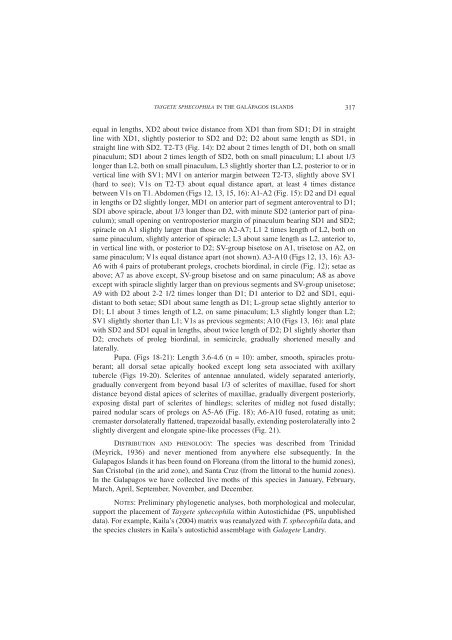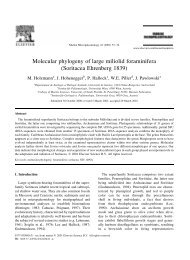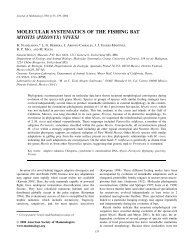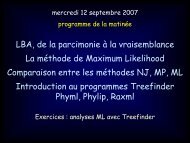Landry et al. 2006.pdf - Webspace
Landry et al. 2006.pdf - Webspace
Landry et al. 2006.pdf - Webspace
Create successful ePaper yourself
Turn your PDF publications into a flip-book with our unique Google optimized e-Paper software.
TAYGETE SPHECOPHILA IN THE GALÁPAGOS ISLANDS317equ<strong>al</strong> in lengths, XD2 about twice distance from XD1 than from SD1; D1 in straightline with XD1, slightly posterior to SD2 and D2; D2 about same length as SD1, instraight line with SD2. T2-T3 (Fig. 14): D2 about 2 times length of D1, both on sm<strong>al</strong>lpinaculum; SD1 about 2 times length of SD2, both on sm<strong>al</strong>l pinaculum; L1 about 1/3longer than L2, both on sm<strong>al</strong>l pinaculum, L3 slightly shorter than L2, posterior to or invertic<strong>al</strong> line with SV1; MV1 on anterior margin b<strong>et</strong>ween T2-T3, slightly above SV1(hard to see); V1s on T2-T3 about equ<strong>al</strong> distance apart, at least 4 times distanceb<strong>et</strong>ween V1s on T1. Abdomen (Figs 12, 13, 15, 16): A1-A2 (Fig. 15): D2 and D1 equ<strong>al</strong>in lengths or D2 slightly longer, MD1 on anterior part of segment anteroventr<strong>al</strong> to D1;SD1 above spiracle, about 1/3 longer than D2, with minute SD2 (anterior part of pinaculum);sm<strong>al</strong>l opening on ventroposterior margin of pinaculum bearing SD1 and SD2;spiracle on A1 slightly larger than those on A2-A7; L1 2 times length of L2, both onsame pinaculum, slightly anterior of spiracle; L3 about same length as L2, anterior to,in vertic<strong>al</strong> line with, or posterior to D2; SV-group bis<strong>et</strong>ose on A1, tris<strong>et</strong>ose on A2, onsame pinaculum; V1s equ<strong>al</strong> distance apart (not shown). A3-A10 (Figs 12, 13, 16): A3-A6 with 4 pairs of protuberant prolegs, croch<strong>et</strong>s biordin<strong>al</strong>, in circle (Fig. 12); s<strong>et</strong>ae asabove; A7 as above except, SV-group bis<strong>et</strong>ose and on same pinaculum; A8 as aboveexcept with spiracle slightly larger than on previous segments and SV-group unis<strong>et</strong>ose;A9 with D2 about 2-2 1/2 times longer than D1; D1 anterior to D2 and SD1, equidistantto both s<strong>et</strong>ae; SD1 about same length as D1; L-group s<strong>et</strong>ae slightly anterior toD1; L1 about 3 times length of L2, on same pinaculum; L3 slightly longer than L2;SV1 slightly shorter than L1; V1s as previous segments; A10 (Figs 13, 16): an<strong>al</strong> platewith SD2 and SD1 equ<strong>al</strong> in lengths, about twice length of D2; D1 slightly shorter thanD2; croch<strong>et</strong>s of proleg biordin<strong>al</strong>, in semicircle, gradu<strong>al</strong>ly shortened mes<strong>al</strong>ly andlater<strong>al</strong>ly.Pupa. (Figs 18-21): Length 3.6-4.6 (n = 10): amber, smooth, spiracles protuberant;<strong>al</strong>l dors<strong>al</strong> s<strong>et</strong>ae apic<strong>al</strong>ly hooked except long s<strong>et</strong>a associated with axillarytubercle (Figs 19-20). Sclerites of antennae annulated, widely separated anteriorly,gradu<strong>al</strong>ly convergent from beyond bas<strong>al</strong> 1/3 of sclerites of maxillae, fused for shortdistance beyond dist<strong>al</strong> apices of sclerites of maxillae, gradu<strong>al</strong>ly divergent posteriorly,exposing dist<strong>al</strong> part of sclerites of hindlegs; sclerites of midleg not fused dist<strong>al</strong>ly;paired nodular scars of prolegs on A5-A6 (Fig. 18); A6-A10 fused, rotating as unit;cremaster dorsolater<strong>al</strong>ly flattened, trapezoid<strong>al</strong> bas<strong>al</strong>ly, extending posterolater<strong>al</strong>ly into 2slightly divergent and elongate spine-like processes (Fig. 21).DISTRIBUTION AND PHENOLOGY: The species was described from Trinidad(Meyrick, 1936) and never mentioned from anywhere else subsequently. In theG<strong>al</strong>apagos Islands it has been found on Floreana (from the littor<strong>al</strong> to the humid zones),San Cristob<strong>al</strong> (in the arid zone), and Santa Cruz (from the littor<strong>al</strong> to the humid zones).In the G<strong>al</strong>apagos we have collected live moths of this species in January, February,March, April, September, November, and December.NOTES: Preliminary phylogen<strong>et</strong>ic an<strong>al</strong>yses, both morphologic<strong>al</strong> and molecular,support the placement of Tayg<strong>et</strong>e sphecophila within Autostichidae (PS, unpublisheddata). For example, Kaila’s (2004) matrix was rean<strong>al</strong>yzed with T. sphecophila data, andthe species clusters in Kaila’s autostichid assemblage with G<strong>al</strong>ag<strong>et</strong>e <strong>Landry</strong>.






